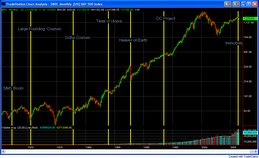Recent coherence project announcements stress the immediate impact of the project on financial markets. Presumably the theory is that coherence improves collective optimism, and optimism moves markets upwards. Thats true in the short-run, but optimism is not a change in the fundamental core of the economy, in the nuts and bolts, bits and photons if you will, of the economy. Its a perception, a change in interpretation about the fundamental core of the economy. Perception, and the core itself, are two quite distinct things.
As pointed out in a prior post, the substantive effects* of the three prior large ME projects took some time to mature and manifest. The immediate short-run effects indeed were negative.
Three patterns or phases (P1,P2,P3 ) emerge upon examining short-run ME effects on financial markets:
- market trends flatten or reverse DURING the project
- 2-14 months after the project market trends are flat or remain within a trading range.
- after this flat period, trends become positive.
- major medical procedure -- the patient experiences a type of shock from the major intervention, sytems flatten or reverse.
- a recouperation phase where the patient rests and heals from a major medical procedure
- a healthy rebound, beyond past levels of vigor, after the patient is fully healed.
For example, "Companies can increase productivity in a variety of ways. The most obvious methods involve automation and computerization which minimize the tasks that must be performed by employees. Recently, less obvious techniques are being employed that involve ergonomic design and worker comfort. A comfortable employee, the theory maintains, can produce more than a counterpart who struggles through the day. ...
Increases in productivity also can influence society more broadly, by improving living standards, and creating income. They are central to the process generating economic growth and capital accumulation.
Many economists see the economic expansion of the later 1990s in the United States as being allowed by the massive increase in worker productivity that occurred during that period. The growth in aggregate supply allowed increases in aggregate demand and decreases in unemployment at the same time that inflation remained stable. Others emphasize drastic changes in patterns of social behaviour resulting from new communication technologies and changed male-female relationships."http://en.wikipedia.org/wiki/Productivity_%28economics%29
"Much of the difference in countries’ living standards reflects differences in their productivity...
... they conceded that during the previous five years [1995-2000] the United States enjoyed the fastest productivity growth in any such period since the second world war. Over the whole period from 1995, labour productivity growth averaged almost 3% a year, twice the average rate over the previous two decades."
http://www.economist.com/research/Economics/alphabetic.cfm?TERM=POPULATION
This fastest pace of productivity gains was during the same period of the most rapid rise in the stiock market in history, the internet boom/bubble. (And correlates with the phase III pattern of the DC Coherence project. )
The structural changes in the economy -- and related social (work ethics), cultural (gender equality in the workplace), political (regulation, tax policy) changes that yield higher productivity - and ultimately are what drive financial markets higher -- do no happen over night. A two week coherence project is not going to produce immediate long-range economic, social, cultural, political, or technolgocal changes.
However, consistent with the inital patterns found in the correlation between past coherence projects and financial markets, it is plausible that there is a incubatory or healing lag between a cohernece project and a long-run sharp rise in financial markets.
For example, many factors contributed to the sharp increase in productivity, and the corresponding market explosive rise 1995-2000. Many many independnet factors had to develop to a critical point, and then come together and interact in new ways: fiber optic capacity, miles of fiber optics layed, development of web browsers and related languages -- HTML, Java -- fast, highly scalable servers, faster, cheaper more accessible PCs and GUI operating systems, innovations in and huge inflows of funds to capital to venture capital financing sources, wide-spread use of stock options and other performance compensation, wide accessability of the internet to the public, increasing broadband availability, telephone and cable companies laying fiber-optic backbones to enable broadband services, the fluorishing of innovative business models (Amazon, E-bay, etc) .
The above changes did not happen over night -- or during a 2-6 week coherence project. The DC project, if it had an effect on financial markets, did not immediately transform the economy via such changes. To expect immediate substantial rises in the market resulting from a cohernece course is naive and "magical" thinking.
It is however at least conceptually plausible, that the DC course created a short perieod of intense coherence, and that this coherence -- via yet to be understood "black-box" mechanisms active over the next 18 months, created a strong healing, renovation , rejuvination and/or integrative forces in all the various diverse factors that drove the productivity gains of 1995-2000 --- and subsequently (over)drove the stock market to substantially higher levels.
* if the market changes are actually caused by ME -- yet to be conclusively demonstrated.


No comments:
Post a Comment